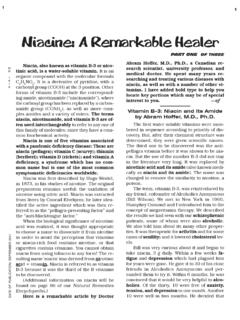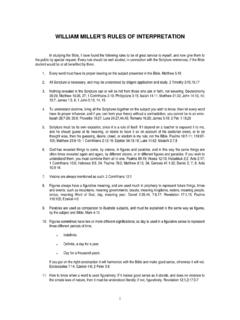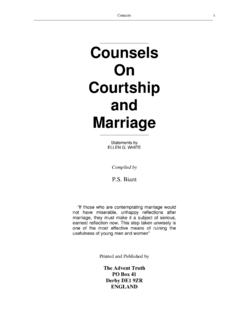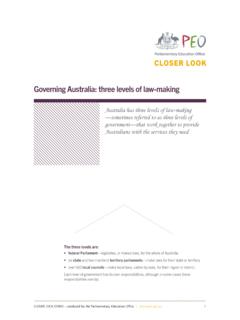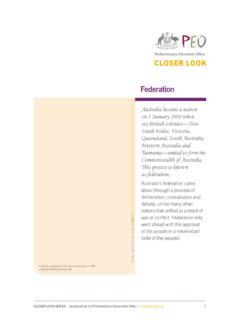Transcription of WHEN WAS THE POPE TAKEN CAPTIVE? A Closer …
1 A Closer look at 1798WM1353 DATE OF PUBLICATION: NOVEMBER 2006It is generally understood that the 1260-yearprophecy ended in 1798, when a pope was takencaptive by one of Napoleon s leading generals. Hereis what Great Controversy says about this: The periods here mentioned forty and twomonths, and a thousand two hundred and three-score days are the same, alike representing thetime in which the church of Christ was to sufferoppression from Rome. The 1260 years of papalsupremacy began in 538, and would there-fore terminate in 1798. At that time a French armyentered Rome and made the pope a prisoner, andhe died in exile.
2 Though a new pope was soon after-ward elected, the papal hierarchy has never sincebeen able to wield the power which it before pos-sessed. The persecution of the church did not continuethroughout the entire period of the 1260 years. Godin mercy to His people cut short the time of theirfiery trial. In foretelling the great tribulation to be-fall the church, the Saviour said: Except those daysshould be shortened, there should no flesh be saved:but for the elect s sake those days shall be short-ened. Matthew 24:22. Through the influence of theReformation the persecution was brought to an endprior to 1798.
3 Great Controversy, in the same book, we are told: The influence of Rome in the countries that onceacknowledged her dominion is still far from beingdestroyed. And prophecy foretells a restoration ofher power. I saw one of his heads as it were woundedto death; and his deadly wound was healed: and allthe world wondered after the beast. Verse 3. Theinfliction of the deadly wound points to the down-fall of the papacy in 1798. After this, says theprophet, his deadly wound was healed: and all theworld wondered after the beast. Great Contro-versy, are declaring that no pope was TAKEN cap-tive in the year 1798.
4 The following quotation, fromwhat has been considered a reputable historical source,declares that the pope was actually TAKEN captive in1799. Some are using this quotation in an attemptto disprove that the pope was TAKEN captive in 1798! Pope Pius VI was on good terms with the alliesagainst France in 1793 and felt that he could relyon them, but in 1796 his territory was invaded. Af-ter the last Austrian defeat by Napoleon, who forcedthe pope to sign a peace treaty at Tolentino on Feb-ruary 19, 1797. In the following December, a riot in Rome ledto French occupation of that city on February 15th,1798, and the proclamation of a republic by a groupof Italian patriots.
5 Pius and the Curia were expelledfrom Rome [in 1798], and in 1799 he was seizedby the French. Aged and physically crippled, hedied a prisoner. Encyclopedia Britannica, , p. 484 (15th ed., 1986).It is generally considered that few historical collec-tions can equal the Encyclopedia Britannica; yet it onlyconsists of a large collection of articles written by menwho can be very this particular case, the above article is inaccu-rate in several Papal States (an area in central Italy consid-ered, in the 18th century, to be the private property ofthe papacy) had, over the centuries, often been invadedby other Italian city-states and foreign nations.
6 Thusnothing of serious consequence happened in 1797, the pope signed a peace treaty withFrance. But this event is also not significant. Over thecenturies, the Vatican has signed (and later broken)many peace treaties with foreign December 1797, there was a riot in Rome. Butthat proves nothing. There have been many riots 1798, a republic was declared by a group ofItalian patriots. That would be a more significantevent, and it happened in 1798. (It was actually in-cited by revolutionists in town who favored a Frenchtakeover.)In 1798, the pope, along with his entire Curia, wereexpelled from far, the above Britannica article is correct.
7 Butthen it says he was seized by the French in ! He was seized by the French in 1798, madea captive , and was never again permitted to resumehis rule over the worldwide Roman Catholic Church!The Britannica article also states that Pius VI wasremoved from Rome in 1799. Also incorrect! Hewas carried captive from Rome in addition, the above 15th edition Britannica state-ment is also in error in declaring that a republic wasdeclared by local Italians. That is also wrong! It wasFrench military officers under General Berthier (pro-nounced B r-thee-a; a as in day ) which made thePapal States into a republic.
8 According to historians,French military officers authored the decree; and it wasissued under their authority (although it may have beencarried out by Italian revolutionists). It is well-knownamong scholars that, after the 11th edition, BritannicaWHEN WAS THE POPE TAKEN CAPTIVE? ALSO IN THIS ISSUE: CHERIES AND ANTHOCYANINS / THE PENTECOSTAL EXPLOSION2 Waymarksis not as historically reliable as in earlier years. MurlVance personally told me that, prior to releasing the12th edition, historical material unfavorable to Romewas altered or crucial points are these: Pope Pius VI wasseized by the French in 1798, not 1799.
9 As a pris-oner he was removed from Rome in 1798, not the time that he was expelled from the city, hewas TAKEN captive not a year afterward. Here are sev-eral historical statements which solidly corroboratethese points. In 1795 Pius VI joined the coalition of Euro-pean powers against France and put an army oftwelve thousand men in the field. Napoleon Bo-naparte, at the head of the victorious French army,seized the pope s possessions in Bologna andFerrar and compelled him to pay an indemnity oftwenty-one million francs. When the pope resortedto efforts at evasion [attempts to avoid paying themoney], the indemnity was increased.
10 In 1798,Rome was captured by the French, a republicwas proclaimed, and the pope was TAKEN toFrance as a prisoner, where he died, August1799. Albert Henry Newman, Manual ofChurch History, Vol. 2, p. 444 (1931). After the [Reign of] Terror [in France] came aconservative reaction, and in 1795 a new constitu-tion placed the state [French nation] under the gov-ernment of a Directory [parliament]. Religious free-dom was proclaimed, but the Directory and its re-gime were anti-Christian. In 1798 the armies ofthe Directory created a republic in Rome andthe Pope (Pius VI, reigned 1775-1799), who hadbeen hostile to the Revolution, was carried toFrance, a prisoner, and within a few months wasdead.

